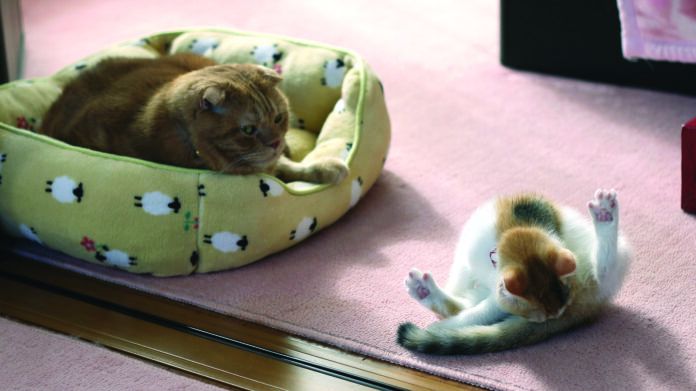One of your cats appears to be lording it over another one. She won’t let him near his food bowl and growls at him if he so much as tries to cross her path, while the cat under assault spends a lot of time hiding, doesn’t try to claim what’s rightfully his, and avoids eye contact. It looks a lot like one cat is bullying, and on a certain level she is. But a cat whose behavior seems bullying may actually feel threatened herself. She may feel like she doesn’t have all the resources she needs to live securely and has decided to take the matter into her own paws. Take heart. There’s a lot you can do to remedy the situation. But first you have to figure out whether the two cats are actually at odds.
Are your two cats fighting or playing?
Some cats like to wrestle and chase each other, and it might seem at first glance that they are not getting along. But they might simply be roughhousing. The way to tell is by noting if they take periodic breaks, says Kelly St. Denis, DVM, a past president of the American Association of Feline Practitioners who was interviewed by care.com for an article on so-called feline bullying. Also, she says, the spirited physicality should be initiated by both cats equally. If it’s one cat who always starts high jinx that resembles fighting, that’s not a good sign.
Another signal that there’s a problem between two cats is that one of them will consistently act more aggressively.
The more aggressive cat:
Never backs away.
Stares down the other cat.
Denies the other cat access to food and other resources, including desirable lounging spots.
Claims territory by leaving her scent at cat height by rubbing her cheeks, head, and chin on doorways and furniture.
An aggressive cat may also stalk another cat while lowering her head and neck and elevating her hindquarters, the Ohio State University School of Veterinary Medicine points out. And it may growl and hiss at the other cat.
The cat who feels threatened, on the other hand, will engage in the following behaviors:
Keeps away from the other cat as well as the rest of the family, often hiding.
Avoids eye contact with the assertive cat and perhaps other cats in the home.
Doesn’t put up a fight about resources, even if they are right-
fully his.
Such a cat may even develop cystitis or other stress-related health problem.
What you can do to smooth things over
It’s important to keep in mind that most likely, the cat bullying the other cat is not doing it just to establish supremacy. As we suggested, the “bully” probably feels uneasy herself, fearing that she will not have enough resources — food, water, toys, attention from the people in the household — if she does not keep zealous guard over all the feline resources in the home. So how can you assure that cat that she will not be deprived and at the same time help the assault-ed cat have equal access throughout the home?
First, keep a separate set of physical resources for each cat, and in separate areas. The food bowl, water bowl, and toys can be divvied up evenly so that each pet realizes they have enough on their own and that it’s no more or less than what the other cat has. If you can keep the resources apart to the point that a cat can enjoy them in privacy, so much the better.
Ideally, this separate-but-equal treatment will extend to window perches, climbing structures, scratching posts, and so on. It costs some money up front but will lead to greatly improved psychological health all around.
Of course, many homes simply do not have the square footage to completely separate the resources of two cats living there. That’s okay. If you’re short on space to the point that cats have to be together to eat or lounge, create more space vertically. Cats love to hang out in high spots such as shelves, window perches, and climbing trees. If you go up as well as out, your cats will have more of a sense of physical distance when they want it, even if they are in the same vicinity.
Third, play with each cat. It’s fine if you want to play with both of them together sometimes, but they should also have some one-on-one time with you. In many ways, you are their primary resource, and they should know that at least for a little bit of time every day, they have sole access to you. This goes for petting, too. Make a conscious effort to give each cat his or her due.
You may have to keep your two cats in separate rooms for a while and reintroduce them very gradually. That’s okay. Remember, cats are solitary creatures by nature, so if they need a cooling-off period during which they are both assured that they will continue to have enough of whatever they need, so be it. In the end, it will mean there’s a much better chance of resolving the tension.





Yeah-once had 5 cats, most got along except Akemi & Mariko-meowrr! Fed them in different areas.
I
We introduced a 4 year old sphyx to a bonded pair of easygoing
13 year old domestic shorthair littermates almost 4 months ago. They have been grieving some time for their bonded sphynx sister. I cant tell what their relationship actually is. The new one swats at the others’ tails and they often ignore her. They all sleep with us sometimes until one decides to swat and hiss at the other. It is not a long event. I actually think the new one wants their attention and to play with them. We have interactive toys they join together with. They all get individual human time. How we determine what to do for them?